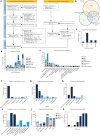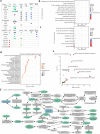Biomarkers of hypoxic-ischemic encephalopathy: a systematic review
- PMID: 37084165
- PMCID: PMC10199106
- DOI: 10.1007/s12519-023-00698-7
Biomarkers of hypoxic-ischemic encephalopathy: a systematic review
Abstract
Background: Current diagnostic criteria for hypoxic-ischemic encephalopathy in the early hours lack objective measurement tools. Therefore, this systematic review aims to identify putative molecules that can be used in diagnosis in daily clinical practice (PROSPERO ID: CRD42021272610).
Data sources: Searches were performed in PubMed, Web of Science, and Science Direct databases until November 2020. English original papers analyzing samples from newborns > 36 weeks that met at least two American College of Obstetricians and Gynecologists diagnostic criteria and/or imaging evidence of cerebral damage were included. Bias was assessed by the Newcastle-Ottawa Scale. The search and data extraction were verified by two authors separately.
Results: From 373 papers, 30 met the inclusion criteria. Data from samples collected in the first 72 hours were extracted, and increased serum levels of neuron-specific enolase and S100-calcium-binding protein-B were associated with a worse prognosis in newborns that suffered an episode of perinatal asphyxia. In addition, the levels of glial fibrillary acidic protein, ubiquitin carboxyl terminal hydrolase isozyme-L1, glutamic pyruvic transaminase-2, lactate, and glucose were elevated in newborns diagnosed with hypoxic-ischemic encephalopathy. Moreover, pathway analysis revealed insulin-like growth factor signaling and alanine, aspartate and glutamate metabolism to be involved in the early molecular response to insult.
Conclusions: Neuron-specific enolase and S100-calcium-binding protein-B are potential biomarkers, since they are correlated with an unfavorable outcome of hypoxic-ischemic encephalopathy newborns. However, more studies are required to determine the sensitivity and specificity of this approach to be validated for clinical practice.
Keywords: Biomarker; Hypoxic–ischemic encephalopathy; Neonatal brain injury; Neuron-specific enolase; Newborn; S100-calcium-binding protein-B.
© 2023. The Author(s).
Conflict of interest statement
The authors have no conflicts of interest to disclose. No financial or non-financial benefits have been received or will be received from any party related directly or indirectly to the subject of this article."
Figures


References
Publication types
MeSH terms
Substances
Grants and funding
- SFRH/BD/143442/2019/Fundação para a Ciência e Tecnologia - Portugal
- 2020.07749.BD/Fundação para a Ciência e Tecnologia - Portugal
- PD/BD/135178/2017/Fundação para a Ciência e Tecnologia - Portugal
- POCI-01-0145-FEDER-029311/Fundação para a Ciência e Tecnologia - Portugal
- POCI-01-0247-FEDER-045311/Fundação para a Ciência e Tecnologia - Portugal
LinkOut - more resources
Full Text Sources
Miscellaneous

